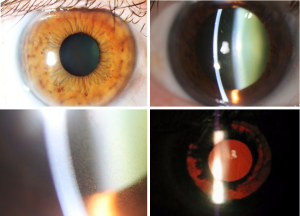Pigment Dispersion Syndrome
Pigment dispersion syndrome is an anatomical-clinical entity characterised by a release of constituents from the iris pigment epithelium which are then transported by the aqueous humour and deposited on various structures of the anterior segment, particularly at the level of the trabecular meshwork [1]. The progressive accumulation of pigment granules can lead to an increase in intraocular pressure (IOP) and, in the case of subsequent glaucomatous optic neuropathy, to a particular form of open-angle glaucoma called pigmentary glaucoma.
Pigment dispersion syndrome, whether or not complicated by glaucoma, mainly affects young, myopic, male adults [2]. The release of pigment is thought to be related to a particular anatomical configuration of the iris: a concavity of the iris results in close contact between the posterior surface of the iris and the anterior surface of the lens and the anterior zonular fibres. During variations in pupil size, particularly in mydriasis, the zonular fibres and the lens would erode the pigment epithelium, resulting in the release of pigment. The accumulation of pigments in the trabecular meshwork would probably reduce the capacity to evacuate aqueous humour and cause an increase in IOP.

Figure 1. Alternating pigmented and atrophic areas (top left). Pigment release after pupillary dilation (top right). Pigmented tyndall at high magnification (bottom left). Transilluminated areas (bottom right).
Pigment dispersion is usually bilateral. It is often discovered incidentally when pigment deposits are found on the structures of associated glaucoma, and laser trabeculoplasty or filtering surgery may be considered. It should be noted that laser trabeculoplasty, whether selective or not, is generally effective in patients with pigmentary glaucoma but may be followed by significant pressure spikes that are difficult to control. Therefore, an adaptation of the energy level and the number of impacts must be performed.
CONTACT
You want to make an appointment? You can either call one of the 5 sites via the button below, or make an appointment directly online in the Contact section, or send me a message in the Contact section
The ophthalmology secretaries and Dr. Qin’s team are available to answer all your questions and requests for information in order to make the best choice. I will be pleased to welcome you at one of the 5 sites.

